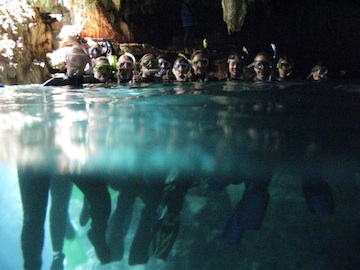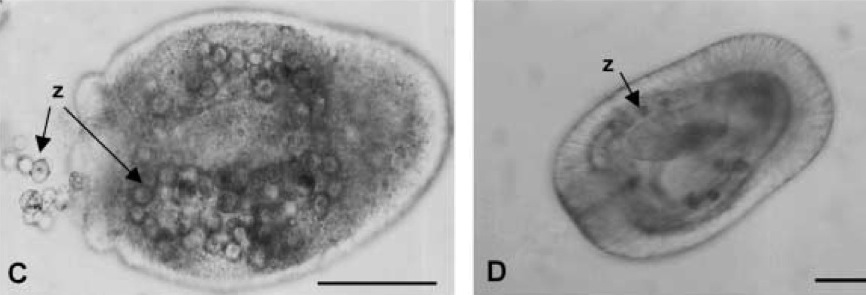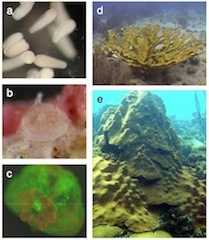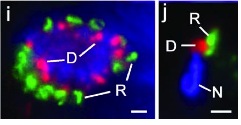This course explores the underlying biology, geology, and oceanography of the coral reef ecosystem, both in the lab and in the field. Weekly exercises will introduce techniques in coral research along with methods to study the effects of environmental degradation. A research field trip during the Spring Break will be conducted at the Bermuda Institute for Ocean Sciences. Participants in this class must be comfortable living in tropical field conditions (wet, salty, crowded), and be confident swimmers. Ms. Schwarz, Mr. McAdoo
All posts by Jodi Schwarz
Understanding the Intracellular Niche in Cnidarian-Dinoflagellate Symbioses: Parasites Lead the Way
Coral life history and symbiosis: functional genomic resources for two reef building Caribbean corals
Scleractinian corals are the foundation of reef ecosystems in tropical marine environments. Their great success is due to interactions with endosymbiotic dinoflagellates (Symbiodinium spp.), with which they are obligately symbiotic. To develop a foundation for studying coral biology and coral symbiosis, we have constructed a set of cDNA libraries and generated and annotated ESTs from two species of corals, Acropora palmata and Montastraea faveolata.
Bioinformatics BIOL/CS353
Our very first group of Bioinformatics students appreciating protein translation at CSHL.
A novel rhoptry protein in Toxoplasma gondii bradyzoites and merozoites
The secretory organelles of Toxoplasma gondii orchestrate invasion of the host cell and establish the parasitophorous vacuole. Although much has been learned about the roles played by these organelles in invasion by the tachyzoite stage, little is known about the contents or functions of these organelles during bradyzoite development or pathogenesis. We identified a novel protein that localizes to the rhoptries of the bradyzoite stage, but is absent from the tachyzoite stage. This protein, BRP1, first appears in the nascent rhoptries during the first division of bradyzoite stage development.We observed secretion of BRP1 and other rhoptry proteins into the parasitophorous vacuole during bradyzoite development in vitro, but there was no evidence that this occurs in vivo. Brp1 knockout parasites did not appear to have any developmental or growth defects in vitro, and were able to establish infections in mice both as tachyzoites (via intraperitoneal injection of in vitro-derived tachyzoites) or bradyzoites (via oral gavage using cysts harvested from mouse brain). Mice infected using brain cysts from the brp1 knockout or the control strain developed similar numbers and sizes of brain cysts. Thus BRP1 does not appear to play an essential role in development of the bradyzoite stage, development of brain cysts, or oral infection of new hosts, at least in the mouse model used here. Since we also observed that BRP1 is expressed in the merozoite stages in the gut of infected cats, the coccidian phase of the life cycle may be where BRP1 plays its most important role.
Aspects of the larval biology of the sea anemones Anthopleura elegantissima and A. artemesia
We investigated several aspects of the larval biology of the anemone Anthopleura elegantissima, which harbors algal symbionts from two different taxa, and the non-symbiotic A. artemisiu. From a 7-year study, we report variable spawning and fertilization success of A. elegantissima in the laboratory. We examined the dynamics of symbiosis onset in larvae of A . elegantissima. Zoochlorellae, freshly isolated from an adult host, were taken up and retained during the larval feeding process, as has been described previously for zooxanthellae. In addition, larvae infected with zooxanthellae remained more highly infected in high-light conditions, compared to larvae with zoochlorellae, which remained more highly infected in low-light conditions. These results parallel the differential distribution of the algal types observed in adult anemones in the field and their differential tolerances to light and temperature. We report on numerous failed attempts to induce settlement and metamorphosis of l a rva e of A . eleguntissima, using a variety of substrates and chemical inducers. We also describe a novel change in morphology of some older planulae, in which large bulges, resembling tentacles, develop around the mouth. Finally, we provide the first description of planulae of A. artemisia and report on attempts t o infect this non-symbiotic species with xooxanthellae and zoochlorellae.
Feeding behavior and acquisition of symbiotic dinoflagellates by larvae of the sea anemone Anthopleura elegantissima
Symbiotic associations between cnidarians and photosynthetic dinoflagellates (i.e., zooxanthellae) are common in the marine environment. Many symbiotic cnidarians produce offspring that are initially nonsymbiotic. These new hosts must acquire symbiotic algae from environmental sources. We examined zooxanthella acquisition by laboratory-reared planula larvae of the temperate sea anemone Anthopleura elegantissima. Larvae ingested zooxanthellae while they were feeding. However, the signal that prompted larval feeding behavior did not originate from the symbiotic algae; the addition of algal cells to larval cultures never elicited a feeding response. In contrast, the addition of macerated animal tissue from several sources invariably generated a strong feeding response, which resulted in the larvae indiscriminately ingesting any particulate matter that was present, including zooxanthellae or other unicellular algae. Ingested zooxanthellae were incorporated into endodermal cells, where they remained undigested, while all other ingested material was digested or expelled within 24 h. Our results provide evidence that one source of ooxanthellae likely to serve as a route of infection in the natural environment is zooxanthella-laden mucus egested by anemones. This egested material fulfilled both of the criteria necessary
for successful infection: it prompted larvae to begin feeding and provided an abundant supply of zooxanthellae that were ingested and taken up into endodermal cells of the new host.
Late Larval Development and Onset of Symbiosis in the Scleractinian Coral Fungia scutaria
J. A. Schwarz, D. A. Krupp and V. M. Weis
Department of Zoology, Oregon State University, Corvallis, Oregon 97331
Many corals that harbor symbiotic algae (zooxanthellae) produce offspring that initially lack zooxanthellae. This study examined late larval development and the acquisition of zooxanthellae in the scleractinian coral Fungia scutaria, which produces planula larvae that lack zooxanthellae. Larvae reared under laboratory conditions developed the ability to feed 3 days after fertilization; feeding behavior was stimulated by homogenized Artemia. Larvae began to settle and metamorphose 5 days after fertilization. In laboratory experiments, larvae acquired experimentally added zooxanthellae by ingesting them while feeding. Zooxanthellae entered the gastric cavity and were phagocytosed by endodermal cells. As early as 1 h after feeding, zooxanthellae were observed in both endodermal and ectodermal cells. Larvae were able to form an association with three genetically distinct strains of zooxanthellae. Both zooxanthellate and azooxanthellate larvae underwent metamorphosis, and azooxanthellate polyps were able to acquire zooxanthellae from the environment. Preliminary evidence suggests that the onset of symbiosis may influence larval development; in one study symbiotic larvae settled earlier than aposymbiotic larvae. Protein profiles of eggs and larvae throughout development revealed a putative yolk protein doublet that was abundant in eggs and 1-day-old larvae and was absent by day 6. This study is the first to examine the onset of symbiosis between a motile cnidarian host and its algal symbiont.









